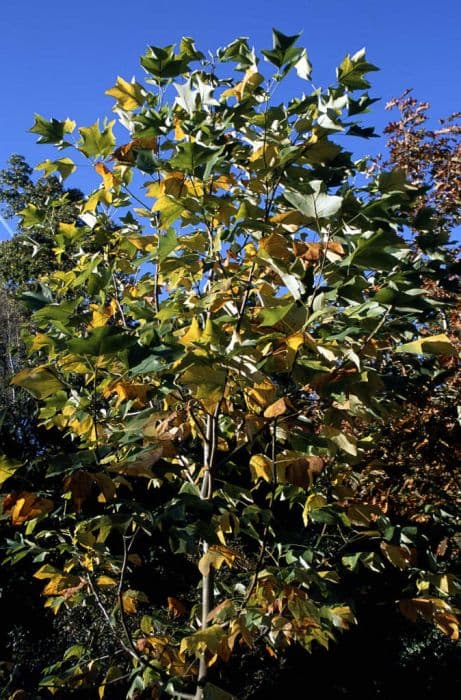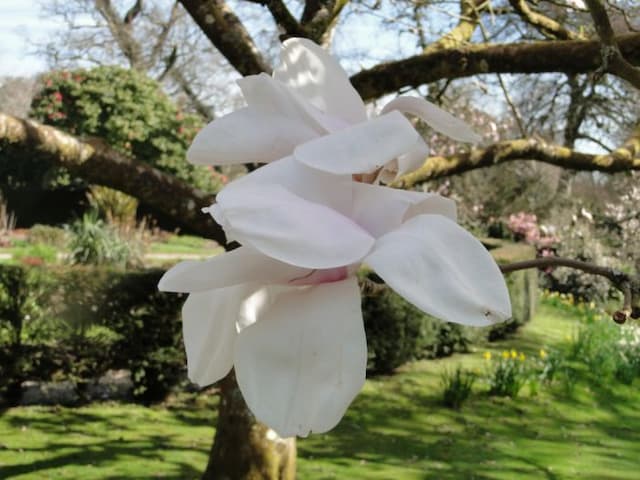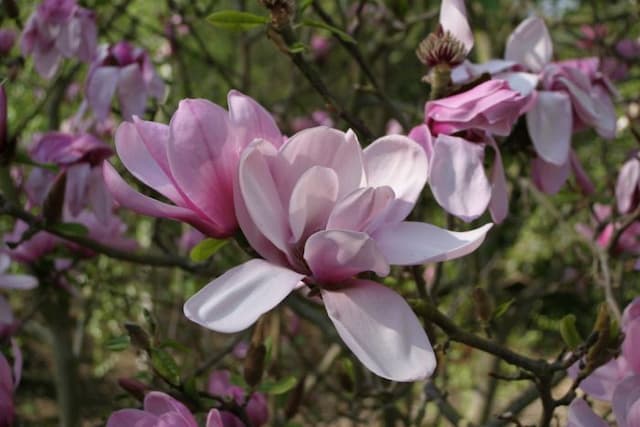Wilson's Magnolia Magnolia wilsonii 'Highdownensis'

ABOUT
Magnolia wilsonii 'Highdownensis' is a visually striking plant that is most commonly known as Wilson's Magnolia. The plant is celebrated for its beautiful and fragrant flowers. These blossoms are pendulous with a cup-and-saucer shape, creating an elegant drooping appearance. The flowers are predominantly white, with a flush of pink at the base, and they are characterized by a central cluster of crimson stamens which add a vibrant contrast to the creamy petals. The leaves of Wilson's Magnolia are lush and green, providing a perfect backdrop for the spectacular floral display. These leaves are typically oblong, broad, and have a smooth, leathery texture with an occasional glossy finish, contributing to the plant's overall ornamental value. Along with its flowering beauty, the plant's general structure can be described as having a spreading habit, with branches that often arch gracefully. This makes it an excellent choice for gardeners looking to create a focal point with a visually appealing silhouette. The bark is a smooth gray, adding to the plant's aesthetic with a mature and refined look. In the appropriate seasons, Wilson's Magnolia also bears fruit that come in the form of elongated, pinkish-red seeds, often admired for their ornamental quality as well. Overall, Wilson's Magnolia 'Highdownensis' is a delight for the senses with its striking and fragrant flowers, glossy foliage, and elegant structure, making it a cherished specimen for plant enthusiasts and a beloved feature in gardens where it can be admired for its ornamental grandeur.
About this plant
 Names
NamesSynonyms
Wilson's Magnolia, Highdown Magnolia
Common names
Magnolia sieboldii subsp. wilsonii, Magnolia wilsonii var. wilsonii.
 Toxicity
ToxicityTo humans
Wilson's Magnolia is not commonly listed as a toxic plant for humans. However, as with many plants, individuals may have allergies or sensitivities to it. Ingesting parts of the plant is not typically associated with poisoning or severe symptoms, but it is generally recommended to avoid consumption of non-food plants. If you suspect ingestion and have concerns about toxicity, it is advisable to consult with a medical professional.
To pets
Wilson's Magnolia is not widely reported to be toxic to pets. However, it is still advisable to discourage pets from ingesting plants, as they can sometimes cause mild stomach upset or an allergic reaction in sensitive animals. If your pet does consume parts of this magnolia and shows any signs of illness, such as vomiting, diarrhea, or unusual behavior, you should contact your veterinarian.
 Characteristics
CharacteristicsLife cycle
Perennials
Foliage type
Deciduous
Color of leaves
Green
Flower color
White
Height
15 feet (4.57 meters)
Spread
10 feet (3.05 meters)
Plant type
Tree
Hardiness zones
7
Native area
China
Benefits
 General Benefits
General Benefits- Ornamental Appeal: Magnolia wilsonii 'Highdownensis' is known for its beautiful, cup-shaped white flowers that offer a striking ornamental presence in gardens.
- Fragrance: The flowers emit a pleasant fragrance, which can create a sensory experience in the landscape.
- Wildlife Attraction: This plant can attract pollinators such as bees and butterflies, contributing to the ecological health of the garden environment.
- Shade Provider: As it matures, the Magnolia wilsonii 'Highdownensis' can provide shade, which might be desirable in certain garden designs.
- Seasonal Interest: It produces flowers in late spring to early summer, adding to the seasonal interest in the garden.
- Low Maintenance: Once established, it generally requires minimal care, which can be beneficial for gardeners looking for lower maintenance options.
- Drought Tolerance: This variety is fairly tolerant of dry conditions once it is well-established, which is useful in areas with water restrictions.
- Architectural Structure: The plant has a strong architectural form that can be used as a focal point in landscape design.
- Longevity: Magnolias are known for their longevity and can become long-lived specimens in the landscape.
- Non-Invasive Roots: The root system is typically non-invasive, making it suitable for planting near built structures without concern for root damage.
 Medical Properties
Medical PropertiesThis plant is not used for medical purposes.
 Air-purifying Qualities
Air-purifying QualitiesThis plant is not specifically known for air purifying qualities.
 Other Uses
Other Uses- Magnolia wilsonii 'Highdownensis', commonly known as Wilson's Magnolia, can be utilized in educational settings such as botanical gardens for the purpose of studying botanical diversity and plant evolution.
- The bark can serve as a natural dyeing agent in small-scale or traditional textile crafts, contributing subtle colors to fabrics.
- Artists have been known to use the pressed flowers or leaves in creating intricate botanical prints or for inclusion in mixed media artwork.
- In perfumery, some attempt harnessing the delicate fragrance of its flowers for crafting bespoke or natural perfumes.
- With its striking flowers, Wilson's Magnolia can be used in photography workshops as a subject to teach techniques of floral and nature photography.
- Cooks interested in edible flowers might experiment with the petals in salads or as garnishes, although one should always verify the safety and edibility beforehand.
- Landscape designers might use this plant for themed gardens, such as Asian-inspired landscapes, due to its geographical origins.
- Wilson's Magnolia wood, if sustainably harvested, could potentially be used in the creation of small woodworking projects or ornamental objects.
- This magnolia variety may be incorporated into mindfulness and meditation gardens, where the serene blooms aid in creating a calming atmosphere.
- During cultural festivals or plant-focused events, branches and blooms could be used in floral arrangements or displays that celebrate plant diversity.
Interesting Facts
 Feng Shui
Feng ShuiThe Magnolia is not used in Feng Shui practice.
 Zodiac Sign Compitability
Zodiac Sign CompitabilityThe Magnolia is not used in astrology practice.
 Plant Symbolism
Plant Symbolism- Nobility: Magnolias are often associated with dignity and splendid beauty, reflecting an air of aristocracy and high esteem.
- Perseverance: The magnolia's ability to withstand harsh climates symbolizes endurance and steadfastness in the face of life's challenges.
- Femininity: With its delicate, large petals, the magnolia is frequently linked to the graceful and gentle aspects of femininity.
- Purity: The magnolia's pristine white flowers signify purity and innocence, often making them a popular choice in floral arrangements for celebrations of new beginnings.
 Water
WaterWilson's Magnolia should be watered thoroughly, soaking the soil to a depth of several inches. During the growing season, water the plant approximately once a week, but adjust frequency depending on weather conditions and soil moisture levels. Aim for about 1 to 1.5 gallons of water per week during dry spells. It's essential to avoid overwatering, as this could lead to root rot. During winter, reduce watering to match the plant's decreased need for moisture.
 Light
LightWilson's Magnolia prefers a spot that receives full sun to partial shade. The best location would provide morning sunlight and some afternoon shade, particularly in hotter climates. It's important to protect the plant from harsh afternoon sun that can scorch the leaves.
 Temperature
TemperatureWilson's Magnolia thrives in temperatures between 60 and 80 degrees Fahrenheit. It can tolerate minimum temperatures down to around 20 degrees Fahrenheit. To ensure optimal growth, protect the plant from extreme temperature fluctuations, particularly sudden frosts that can damage young growth.
 Pruning
PruningPrune Wilson's Magnolia in late winter or early spring before new growth begins. Pruning is mostly for shaping the plant and removing any damaged or dead branches. It's not usually necessary to prune annually, but doing so can help maintain the plant's health and appearance. The best time to prune is after the risk of severe frost has passed, but before the growing season commences.
 Cleaning
CleaningAs needed
 Soil
SoilWilson's Magnolia prefers moist, well-drained, acidic soil with a pH of 5.0 to 6.5. A mix of peat, compost, and pine bark is ideal for ensuring sufficient drainage and acidity.
 Repotting
RepottingWilson's Magnolia does not need frequent repotting; it is typically done every 2 to 3 years when it outgrows its current container.
 Humidity & Misting
Humidity & MistingWilson's Magnolia thrives in high humidity environments, ideally around 50% or higher, mimicking its natural humid woodland habitat.
 Suitable locations
Suitable locationsIndoor
Place Wilson's Magnolia near a window for bright, indirect light.
Outdoor
Plant Wilson's Magnolia in partial shade with shelter from winds.
Hardiness zone
7-10 USDA
 Life cycle
Life cycleThe Magnolia wilsonii 'Highdownensis', commonly known as Wilson's magnolia, begins its life cycle with seed germination, which is facilitated by warm stratification to break seed dormancy. Upon sprouting, the seedling goes through a juvenile phase, developing its root system and a sturdy stem, before producing its first leaves. As the plant matures into the vegetative stage, it develops a characteristic woody structure and larger, deep green leaves. Following vegetative growth, Wilson's magnolia enters the reproductive phase, typically flowering in late spring to early summer, producing fragrant white flowers with a red center, crucial for pollination by insects. After successful pollination, the plant forms cone-like fruit aggregates that mature, releasing red-orange seeds in late summer or fall, which are then dispersed by gravity or animal activity. As a perennial, Wilson's magnolia undergoes yearly cycles of growth, flowering, and fruiting, with the potential to live and reproduce for several decades under optimal conditions.
 Propogation
PropogationPropogation time
Early summer
The Magnolia wilsonii 'Highdownensis', commonly known as Wilson's Magnolia, is typically propagated by semi-hardwood cuttings taken during the late summer months. This method involves selecting healthy, current year's growth stems and cutting them into 6 to 8-inch (15 to 20 cm) lengths. The bottom end of the cutting should be snipped just below a leaf node, and the leaves on the lower half of the stem should be removed. These cuttings can then be dipped in a rooting hormone powder or gel to enhance root development. Afterward, they are inserted into a well-drained potting mix or propagation tray, with the bottom half of the stem beneath the soil surface. The propagation environment should maintain high humidity and stable temperatures between 70 to 75 degrees Fahrenheit (approximately 21 to 24 degrees Celsius), often accomplished with the aid of a propagation mist system or by covering with a plastic dome. Rooting usually occurs within a few weeks to a couple of months, depending on conditions.









![Magnolia [Felix Jury]](/_next/image?url=https%3A%2F%2Fplants-admin.emdemapps.com%2Fimages%2Fplants%2F%2Fimages%2F604b61a0b23b7.png&w=640&q=75)